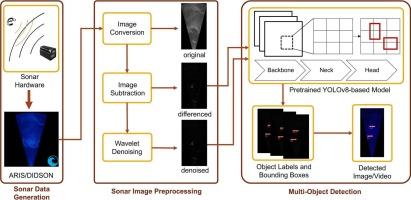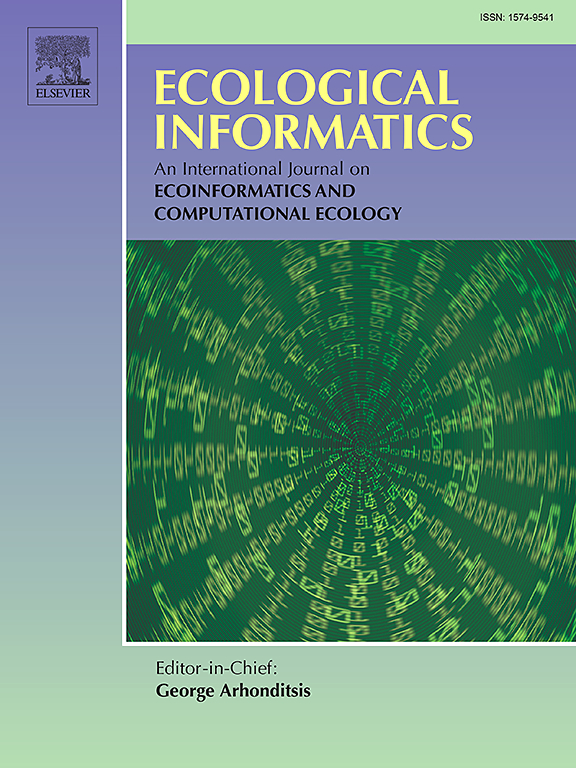Towards automated and real-time multi-object detection of anguilliform fishes from sonar data using YOLOv8 deep learning algorithm
IF 7.3
2区 环境科学与生态学
Q1 ECOLOGY
引用次数: 0
Abstract
Freshwater eels (Anguilla spp.), including American eels (Anguilla rostrata), European eels (Anguilla anguilla), and Japanese eels (Anguilla japonica), are target species for conservation and of regulatory concern due to their vulnerability to various stressors during obligatory migrations from freshwater into oceanic spawning grounds. Accurate and efficient detection of migrating eels can improve our understanding of fish behaviors and fish-hydraulic structure interactions from both ecological and economic perspectives. However, a real-time and automated framework for detecting migrating eels in real-world applications is currently lacking. Leveraging imaging sonar as a reliable technology for fish passage monitoring in dark, turbid and high-flow environments, field data are acquired using imaging sonar and then converted to single sonar frames/images for subsequent analysis. In this study, a framework based on the “You Only Look Once” Version 8 (YOLOv8)-based convolutional neural network is proposed for multi-object detection of eels and non-eel fish using the sonar images after image subtraction and additional wavelet denoising. The results from both training and testing phases demonstrate that the framework's ability can successfully detect both eels and non-eel fish in preprocessed sonar images, achieving F1-scores and [email protected] exceeding 0.80. Additionally, the incorporation of wavelet denoising during preprocessing slightly improves detection performance. Furthermore, the transferability of this framework from eel to lamprey detection is demonstrated to be feasible given the similar morphological characteristics of these two species. Overall, the proposed framework achieves accurate and efficient detection of migrating eels, providing reliable and real-time information that can help conserve vulnerable eel and eel-like species and facilitate the design, operation, and optimization of more effective downstream passage facilities.

利用YOLOv8深度学习算法从声纳数据中实现鳗鱼的自动实时多目标检测
淡水鳗,包括美洲鳗(Anguilla rostrata)、欧洲鳗(Anguilla Anguilla)和日本鳗(Anguilla japonica),是保护和监管的目标物种,因为它们在从淡水到海洋产卵地的强制性迁徙过程中容易受到各种压力的影响。对洄游鳗鱼进行准确、高效的检测,可以从生态学和经济学的角度提高我们对鱼类行为和鱼-水工结构相互作用的认识。然而,目前还缺乏一个实时的、自动化的框架来检测实际应用中的迁移鳗鱼。成像声纳是在黑暗、浑浊和高流量环境中监测鱼类通道的可靠技术,利用成像声纳获取现场数据,然后转换为单个声纳帧/图像进行后续分析。本文提出了一种基于“You Only Look Once”Version 8 (YOLOv8)卷积神经网络的框架,利用图像减相和附加小波去噪后的声纳图像对鳗鱼和非鳗鱼鱼进行多目标检测。训练和测试阶段的结果表明,该框架能够成功地检测预处理声纳图像中的鳗鱼和非鳗鱼鱼,得分达到f1, [email protected]超过0.80。此外,在预处理过程中加入小波去噪可以略微提高检测性能。此外,考虑到鳗鱼和七鳃鳗的相似形态特征,该框架的可移植性被证明是可行的。总体而言,该框架实现了对洄游鳗鱼的准确、高效检测,提供了可靠的实时信息,有助于保护脆弱鳗鱼和类鳗鱼物种,促进更有效的下游通道设施的设计、运营和优化。
本文章由计算机程序翻译,如有差异,请以英文原文为准。
求助全文
约1分钟内获得全文
求助全文
来源期刊

Ecological Informatics
环境科学-生态学
CiteScore
8.30
自引率
11.80%
发文量
346
审稿时长
46 days
期刊介绍:
The journal Ecological Informatics is devoted to the publication of high quality, peer-reviewed articles on all aspects of computational ecology, data science and biogeography. The scope of the journal takes into account the data-intensive nature of ecology, the growing capacity of information technology to access, harness and leverage complex data as well as the critical need for informing sustainable management in view of global environmental and climate change.
The nature of the journal is interdisciplinary at the crossover between ecology and informatics. It focuses on novel concepts and techniques for image- and genome-based monitoring and interpretation, sensor- and multimedia-based data acquisition, internet-based data archiving and sharing, data assimilation, modelling and prediction of ecological data.
 求助内容:
求助内容: 应助结果提醒方式:
应助结果提醒方式:


